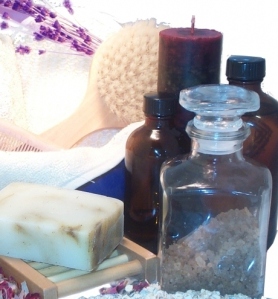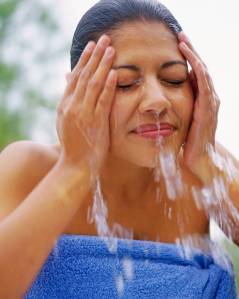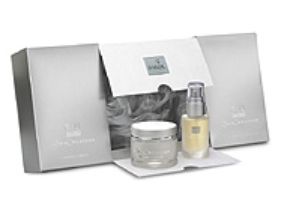How to get healthy skin – part two
Can the secret to healthy skin really be demystified? I am here to let you in on my secret…there is no “secret” to healthy skin, just a lot of common sense!
In part one of “how to get healthy skin” we discussed the benefits of a healthful diet abundant in vegetables and fruit and moderate in healthy proteins. We also talked about the importance of antioxidants and how to make food selections which optimize the external benefits on the skin. With no single correct answer on how to get healthy skin, we will explore our second common sense factor – your skin care regimen.
So many wonder if healthy, beautiful, luminous skin is really possible just by eating right…it’s not likely. Others wonder how they can retain the skin of their youth…nothing lasts forever! So let’s dive into our second article.
Part two of the “how to get healthy skin” series focuses on incorporating a healthy skin care regimen. In short, gently cleanse twice a day for normal, combo and dry skin, cleanse more if you are oily. Treat your skin for any concerns such as acne, wrinkles, crow’s feet, rosacea, dark circles etc. Moisturize twice a day, even if you are oily…don’t freak out oily folks! I will explain how to moisturize your skin with out adding oil. Exfoliate 1-2 times per week except in the summer. Protect your skin daily using an SPF30 during all seasons.
Cleans: Most individuals can cleanse each morning and each night with out causing any concerns. Individuals who are oily may wish to cleans more often, be careful to not over cleans your skin by washing too often (more than 4 times per day) unless you are instructed to do so by your dermatologist. Why cleanse at night? Your skin regenerates at night while you sleep. While you sleep your skin is actively working to repair damage done during the day; this is when your cells are most actively turning over. When you sleep with make-up or other environmental elements on your skin, such as pollution, you are damaging your skin and providing a great foundation for other issues to crop up. Believe it or not, some experts state that you age up to two days for every one night you sleep without cleansing your face before bed. Perhaps that is just a scare tactic to sell more skin care products BUT think about it, how good can it be to sleep with all of the day’s exposure on your skin. Eventually you will see congestion, possible break outs and you will experience generally dull skin. For cleansing, use gentle products with minimal fragrance; remain clear of those apricot pit scrubs! Those are terrible for your skin. Use warm, not hot, water for best results as hot water will over dry and scold your skin. I suggest using an eye make-up remover if you wear mascara and eye liner.
Treat: For those of you that need or like treatment (anyone over the age of 20), most treatments are applied before a moisturizer. Some individuals use a toner and a treatment after cleansing, and this is fine. Toner is applied first, then the treatment. In most cases toner is not entirely necessary but many love it…so tone away if you’d like. For treatment, I am referring to retinol treatments, vitamins (A, C, E), alpha hydroxyl acids, beta hydroxyl acids, antioxidants, etc. Whatever your choice of treatment, they are generally applied under your moisturizer.
Moisturize: This is a critical step in your skin care regimen. Adding hydration to the skin no less than twice per day will help in the appearance of your skins tone, texture and suppleness. Select your moisturizer carefully as you do not want to add oil to your skin, just hydration! Remember moisturizer does not have to mean oil! There are a lot of oil free moisturizers on the market today, nearly every one of your high end or dermatologist recommended products will have oil free hydration options for your skin. Individuals with oily skin should be aware that adding hydration to the skin can greatly help reduce the amount of oil that your skin produces, thereby reducing you’re your chances for acne to form. When you over cleans your skin, or add too much treatment, the skin will naturally produce more oils to help protect itself! Image that! If you would like suggestions on selecting a moisturizer let me know.
Exfoliate no more than twice per week using a mask, peel or scrub. Reduce exfoliation in the summer to once per week or even every other week as your skin will become more sensitive to the sun through the exfoliation process. If you would like recommendations, let me know, I can post some goodies!
Protect: Always wear a sunscreen during the day. Exposure to UV radiation (UVA/UVB) is damaging to the collagen fibers and elastin proteins in your skin. The damages cause premature aging in the form of wrinkles, rough skin, hyperpigmentation, dryness and sallow unattractive skin.
Regardless of the season, sunscreen containing SPF30 or greater should be worn for prolonged sun exposure or anytime when you will be spending more than a few minutes in the sun. If you are just walking from your car to the office, an SPF20 should be fine. If at the beach, gardening or other outside activity, you may want to consider wearing a hat to protect your skin further for the sun’s harmful rays.
Stay tuned for more tips on – how to get healthy skin – part three!
Tags: acne, antioxidant, beauty, care, cleanse, complexion, dark circles, deep wrinkles, exfoliate, Health, moisturize, oil free moisture, oily skin, pimples, protect, regimen, skin, Skin Care, SPF, sun damage, Sunscreen, tone, uv protection, wrinkles
 In a recent press release the Center for Environmental Health identified 26 companies that are engaged in the business of selling personal care products that are mislabeled as “Organic”. Sadly, this is not the first time that the personal care industry has been called out on ingredients contained in their products and labeling on their packaging. At the center of the lawsuit is The California Organic Products Act of 2003, specifically section 110838.(a) of the Health and Safety codes that quote “Cosmetic products sold, labeled, or represented as organic or made with organic ingredients shall contain, at least 70 percent organically produced ingredients.” (Organic Products Act of 2003).
In a recent press release the Center for Environmental Health identified 26 companies that are engaged in the business of selling personal care products that are mislabeled as “Organic”. Sadly, this is not the first time that the personal care industry has been called out on ingredients contained in their products and labeling on their packaging. At the center of the lawsuit is The California Organic Products Act of 2003, specifically section 110838.(a) of the Health and Safety codes that quote “Cosmetic products sold, labeled, or represented as organic or made with organic ingredients shall contain, at least 70 percent organically produced ingredients.” (Organic Products Act of 2003). Cosmeceuticals
Cosmeceuticals



